Technology played a big role in multifamily’s response to the COVID-19 pandemic, but it is the operators who paid attention to the little things that positioned themselves for continued success.
In the 2021 NMHC OPTECH session “Multifamily Moneyball: A Home Run for Talent Management and Customer Experience,” panelists reviewed the subtle strategies and simple tech solutions they deployed with lasting success over the past 20 months. “Moneyball” is the term commonly used to describe the Oakland Athletics low-cost analytics-based approach to building a baseball roster – made famous by the 2003 blockbuster film starring Brad Pitt. As the session name suggests, the discussion focused on a data-centric approach to improving operations, as well as resident and associate retention.
“In the movie, Brad Pitt (playing Oakland A’s General Manager Billy Beane) said to the Yale analyst he hires, ‘I think the question we should be asking is, Do you believe in this thing or not?’,” said Grace Hill CEO Kendall Pretzer. “Do you believe in the data? The movie talks about not hiring the one person who will hit the home run but getting people on base. Rather than waiting for that one big thing in property management, what are all the small things that we can do to make our teams win?”
One of the universal challenges posed by the pandemic was maintaining unity among property teams and cohesion from the corporate level on down.
“We had a lot of meetings,” said David Scharfenberg, Senior Vice President at Waterton. “We used technology, at a time when we were so far apart, to get closer to the associates and really say, ‘We’re with you, we’re going to support you and provide an environment that’s good for you.’”
Scharfenberg said it continues to be crucial that residents and associates know their voices are being heard and their concerns addressed. In addition to virtual meetings, he said introducing open channels of communication and investing in effective communication platforms help create an invaluable two-way exchange.
“As a leadership team, we’re doing a lot of listening,” Scharfenberg said. “You have two ears and one mouth for a reason. Listen twice as much as you talk.”
Soliciting actionable feedback from residents and associates through surveys and open dialogue establishes an important sense of engagement within multifamily communities.
“Engagement is the intersection of an employee feeling highly productive and highly satisfied. In order to feel productive, they need to know what they’re doing and that at the end of the day, all the things I accomplished moved the needle for my team, for my property, and for my company,” said Jen Piccotti, Chief Learning Officer at Swift Bunny. “[Associates] need to understand their purpose to be and feel successful.”
Engaged, satisfied employees help build continuity and longevity among property teams.
“Now people are seeing their leaders, they’re hearing from their leaders, they understand where the company is going, what changes have been made,” Piccotti said. “They’re more willing to stick around because they understand what’s going on and what’s expected of the employee.”
Tech solutions that promote engagement and facilitate associate training are typically inexpensive but pay off exponentially through the cost savings associated with improved turnover rates. According to a recent Swift Bunny report, a three-point decrease in employee turnover yields a four-point increase in resident turnover. Grace Hill found that when property teams are completely engaged, it can lead to as much as a 20% increase in renewal intent.
“Having information available and policies in place is only as good as your adoption rate amongst your site teams – the people who are actually carrying it out,” said Laurel Zacher, Vice President of Marketing and Talent Development at Security Properties Residential. “An investment of time in your internal resources can maximize the systems and technology that you already have in place. Before you look at really broad scope investments in outside technology, start with what you have, then start filling the gaps. Technology adoption doesn’t have to be an overwhelming change in order to have a deep, meaningful impact.”
People-focused products and platforms should be prioritized, especially those that remove burdens from onsite teams, enhance training and performance benchmarking, and improve resident and associate engagement.
“Technology should provide a solution. There’s a lot of technology out there that is really cool and that has a lot of bells and whistles, but you have to answer the question, So what?” Scharfenberg said. “Does this actually add value to our residents or our associates? If not, move on.”



